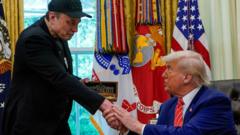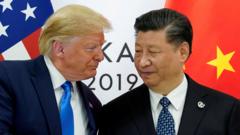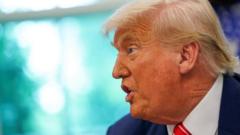With uncertainties surrounding Trump's planned tariffs on imports, businesses and countries brace for potential shifts in the global trade landscape.**
Unraveling the Uncertainty: Trump’s ‘Liberation Day’ Tariffs and Their Implications**

Unraveling the Uncertainty: Trump’s ‘Liberation Day’ Tariffs and Their Implications**
As Trump prepares to unveil new tariffs, key questions remain about their scale, targeted nations, and potential economic impact.**
With just days to go until President Trump reveals the specifics of his new import tariffs, dubbed "Liberation Day," questions swirl regarding their magnitude, scope, and economic ramifications. Trump's approach to tariffs has intensified since taking office, already affecting various imports from key partners like China, Canada, and Mexico. The impending announcement promises to offer insights into a broader tariff strategy, yet much remains unclear.
**How high will the tariffs be?**
The administration has kept its cards close to its chest regarding potential tariff rates, leaving many analysts speculating. During his campaign, Trump hinted at an across-the-board tariff of 10% to 20%, even suggesting 60% for specific imports from China. This was complicated by the concept of "reciprocal" tariffs, where rates could vary based on a country’s own tariffs. The White House’s approach suggests a combination of tariffs along with policies deemed unfair to American businesses, such as VAT, creating a complex picture for American companies attempting to navigate impending changes.
European officials, anticipating the worst, are preparing for double-digit tariffs, particularly with Trump eyeing a 25% tax on EU goods, as stated earlier this year.
**Which nations could face tariffs?**
Speculation continues on which countries will be included in the new tariffs. President Trump has hinted that the scope might be expansive, covering "all countries," undermining expectations from allies like the UK who hoped to be exempt. On the other hand, the administration has focused on the "Dirty 15" – nations responsible for a significant share of US trade that impose unfavorable rules on American firms. Countries of interest include longstanding trading partners and competitors alike, such as Canada, China, and the EU, revealing Trump’s willingness to challenge both friends and foes in the realm of trade.
**What could be the economic impact?**
The crux of the issue lies in the economic consequences of these tariffs, which function as an additional tax on imports. While technically the companies importing goods will bear the burden, it’s likely that they will pass on the costs to consumers through higher prices. Many businesses are already adjusting their strategies, either by altering supply chains or preparing for price increases. This dynamic raises concerns over potential economic slowdown, both domestically and internationally, as consumers may choose to reduce spending in response to rising prices.
Trump suggests that firms can mitigate the impact by relocating operations to the US, but this is complicated by high establishment costs and ongoing supply chain complexities. As nations brace for retaliatory measures and fluctuations in currency values, the unpredictable repercussions of Trump's trade policies present a significant challenge that may extend beyond the immediate announcement.




















